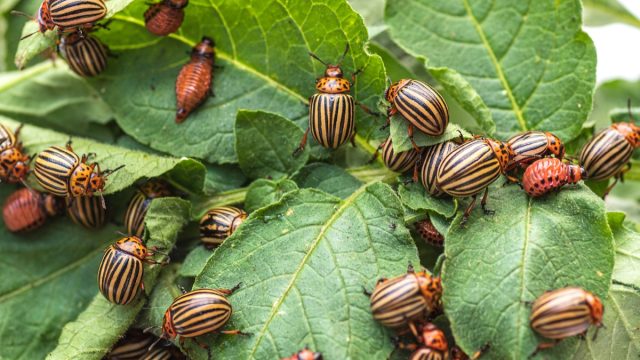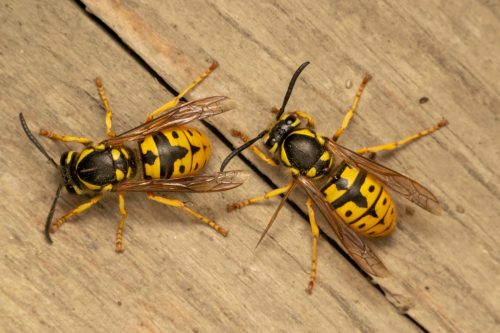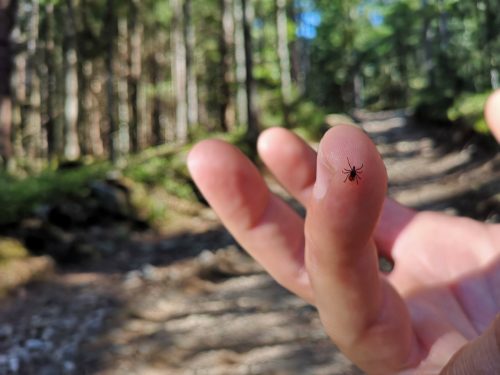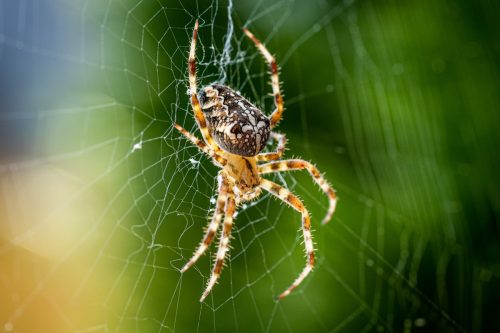The 5 Most Dangerous Insects to Avoid This Fall, According to Experts
You might think they're harmless, but pest pros say otherwise.

You may feel relieved that summer—the high season for buzzing, stinging, and flying pests—is over, but fall has its own set of creepy crawlies to look out for. In addition to being disgusting (at least to most people!), these insects can be incredibly dangerous. The most worrisome part is that many of them seem harmless. To learn how to protect one's self this fall, we spoke to pest experts and scientists about the season's most active bugs. Read on to learn about the five most dangerous insects to avoid this fall—and how to safeguard against them.
READ THIS NEXT: The No. 1 Thing Attracting Mosquitoes to Your Yard.
1
Common Houseflies

In early fall, cooler temperatures lead flies to seek warmth in our homes. While they may not bite, they carry a lot of diseases and bacteria that you may not have realized.
"The list of diseases the common house fly carries and spreads include many of the worst killers of mankind: typhoid, cholera, gangrene, tuberculosis, gonorrhea, bubonic plague, leprosy, diphtheria, scarlet fever, amoebic dysentery, poliomyelitis, and many others," explains Sholom Rosenbloom, owner of Rosenbloom Pest Control. "Some flies prefer the eye and transfer the microbes of pink eye (conjunctivitis) and trachoma from diseased eyes to your healthy eyes. Others spread yaws, a skin disease, when they feed on your cuts and sores."
Each fly can carry as many as six million bacteria on its feet. If it has recently walked in excrement, it can transmit pathogens causing the previously mentioned diseases (along with infectious hepatitis, as well as the eggs of parasitic worms), to humans—mainly children.
To get rid of flies naturally, Rosenbloom suggests making a spray with ginger and basil. "There are certain other home remedies too, which people claimed have worked for them, including apple cider vinegar traps, eucalyptus oil spray, lavender oil spray, and hot pepper spray."
2
Wasps

Wasp stings can be dangerous and potentially lethal if people are allergic. According to the Centers for Disease Control and Prevention (CDC), an average of 62 people die each year from hornet, wasp, and bee stings. And fall is their active season.
"Unlike honeybees, who can protect and maintain a whole colony in their hives overwinters, only queen wasps survive into each spring," explains Charles van Rees, PhD, conservation scientist and naturalist. "They take the entire spring and summer to raise a new brood of young, a few at a time, into a bustling new wasp nest. By fall, these colonies have reached their highest numbers, which means that more wasps are more active hunting food for more babies."
Yellowjackets, a common type of wasp, are notorious for being active in the fall. According to David Price, associate certified entomologist at Mosquito Joe, this is because their food sources are drying up, and they become desperate for sugar in sodas and fermenting fruits. "It is survival of the fittest as winter moves in; the workers will die off and the newly fertilized queens will seek shelter to overwinter and begin a new colony in the spring. A single sting can be life-threatening for a person who is allergic."
The best way to keep wasps away is to make sure you don't leave food sources (sweets, drinks, food) out for them to find. If you have a very large wasp population, a baited wasp trap is an option, as are sprays for individual wasps. To remove a nest that's near or in your home, it's best to call a professional.
For more pest advice delivered straight to your inbox, sign up for our daily newsletter.
3
Ticks

One of North America's most dangerous insects, the deer tick, is at its most active in the fall. This tiny scourge gets busy when other tick species begin to slow down for winter. Fall is when deer ticks complete their life cycle by growing into their adult forms, finding mates, and producing eggs.
"Like other tick life-stages that require growth and molting, this means they need to seek out a blood meal," according to van Rees. "Because they are at their largest—especially the females—and some must produce energy-expensive eggs, it also means they need their largest blood meal of their lives. They are adapted to seek out larger hosts in the fall, which in the past mostly meant deer. Since fall is the mating season for deer, they're especially active and mobile at that time."
The younger life stages of deer ticks can transmit several dangerous diseases, chief among them Lyme disease, from bacteria they may pick up from smaller hosts in earlier stages of their lives. According to van Rees, around 500,000 people in the U.S. contract Lyme disease from deer ticks every year. Other tick-borne diseases include anaplasmosis (a bacterial infection), Rocky Mountain spotted fever, and babesiosis (a red blood cell disease). Younger ticks are more active in summer, but that's no reason to let your guard down in the fall.
To protect yourself from ticks, Price says to use "Environmental Protection Agency (EPA)-registered insect repellents containing DEET, picaridin, IR3535, oil of lemon eucalyptus, para-menthane-diol, or 2-undecanone" when in wooded or leafy areas. In addition, he says to "treat clothing and gear, such as boots, pants, socks, and tents with products containing 0.5% permethrin." And, of course, always check yourself and your pets when you come back indoors.
4
Spiders

Fall, it turns out, is prime mating season for spiders. According to Price, black widow and yellow sac spiders deliver venom with their bite, which can be painful with fever, nausea, and sweating. Brown recluse spider bites are also very painful and can cause necrosis of subcutaneous tissue.
"As the days become cooler, the venomous spiders will move closer or enter our homes," says Price. "Particularly as the temperatures change and they prepare for winter." To guard against this encroachment, "ensure screens are in good repair, doors are sealed and seal up cracks and crevices around the home. Also, be aware that a spider or other insects may be lurking in woodpiles."
READ THIS NEXT: If You See This Bug in Your Home, Don't Step on It, Experts Warn.
5
Bed Bugs

Fall is peak bed bug season. "As families return home from summer trips and kids are back at school, there are plenty of opportunities for bedbugs to hitch rides in bags, backpacks, luggage, and clothing," according to M and M Pest Control.
These tiny, reddish-brown insects hide deep in your mattress and feed on you while you slumber. And while bed bugs aren't medically dangerous (bites are merely itchy and they don't cause diseases) they're extremely difficult and costly to get rid of, making them very dangerous to your sanity, not to mention your social life.
Bed bugs live in mattress seams and folds, in cracks and joints of headboards and bed frames, in corners and screw holes of dressers and nightstands, behind framed wall art, and in cracks along baseboards. The best ways to be vigilant about preventing bedbugs is to make sure you clear out clutter, install door sweeps to keep bugs from migrating from room to room, and check luggage when returning home from a trip (or when kids come home from college).





















